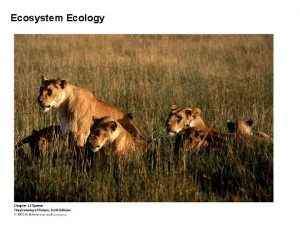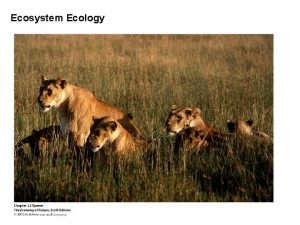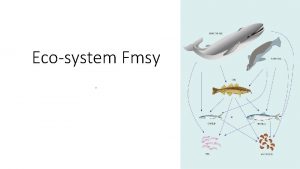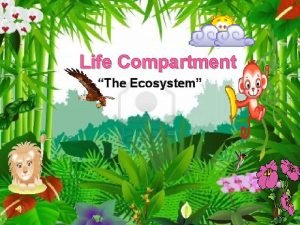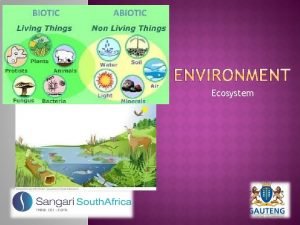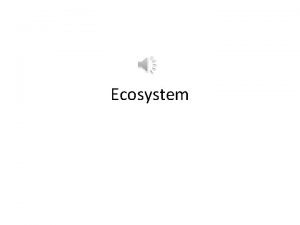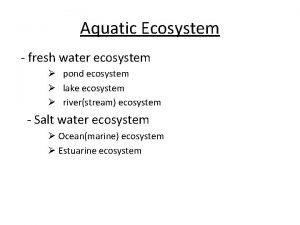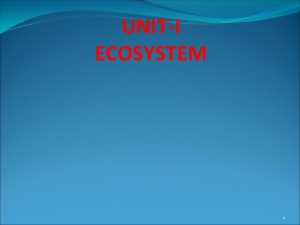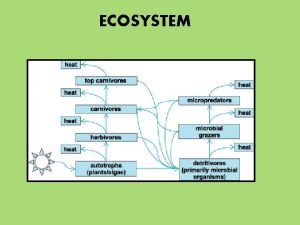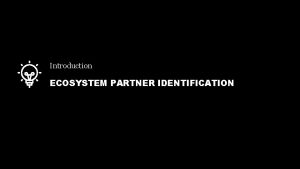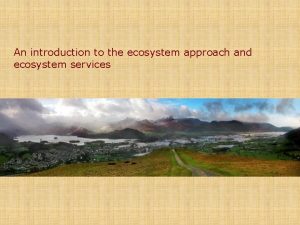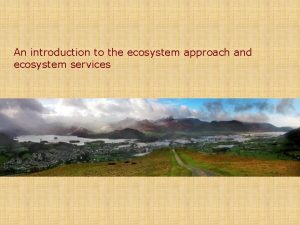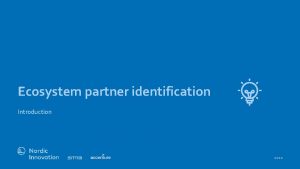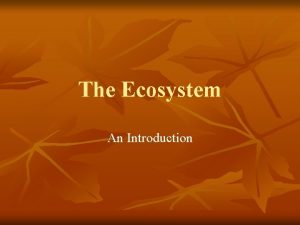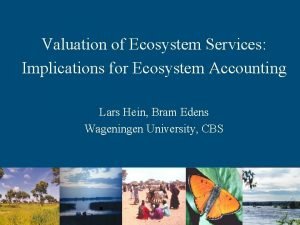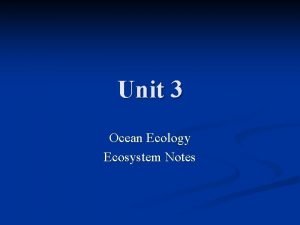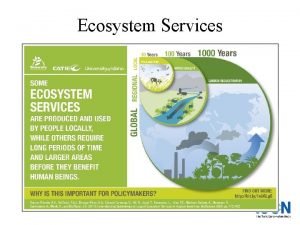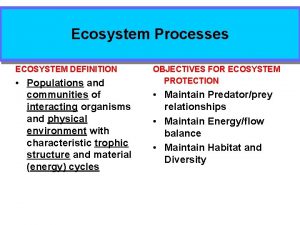The Ecosystem An Introduction Ecosystem n n n


























- Slides: 26

The Ecosystem An Introduction

Ecosystem n n n A community of interdependent organisms and the interactions with the physical environment in which they live. It can also be defined as the abiotic and biotic factors and the interactions between them. The interaction between organisms and the environment is the key!

Differentiate between the following terms: n n n Organism Species Population Community Niche Habitat

In your notebook, draw a picture of a bunch of little organisms n n n Label: The organisms of the same type (species) Circle: individuals of the same species (Population) Draw interactions between the populations (Community)

Compare the terms habitat and niche n Sometimes people confuse these terms. n Figure out the differences between the terms.

Niche vs habitat n n n A habitat is wear an organism lives. The habitat must provide a source of food, water and shelter for the organism. Niche: The role of the organism. This is largely to do with the trophic level of the organism. For example: plants produce food for the rest of the food chain. Tigers keep herbivore populations under control.

Abiotic and Biotic factors Biotic Factor: A living, biological factor that may influence an organism or a system. Example: predation, disease, competition n Abiotic factor: A non-living, physical factor that may influence an organism or a system Examples: Temperature, salinity, p. H, light

Which factors are biotic? n n n n Rabbits Cacti Daylight hours Precipitation Moss Soil composition Bacteria

Limiting factors n n An abiotic factor can limit the population size if there is too much or too little of it. Even if there is the right amount of other factors Examples to consider: Sunlight Precipitation Salinity Nutrients in the soil

Trophic levels Ecostems are often broken up and described according to feeding relationships. Trophic level: n The position of an organism in a food chain n n A group of organisms that occupy the same place in a food chain

Trophic levels in food chains Be able to give an example of each! n Primary producers (autotrophs) n Primary consumers (herbivores) n Secondary consumers(carnivores) n Tertiary consumers (top carnivores) n Decomposers n Detrivores n Scavengers

Energy flow and material cycling

Producer Autotroph - “self” + “feed” l. An organism that obtains organic food l molecules without eating other organisms but by using energy from the sun or inorganic molecules to make organic molecules l Remember: This trophic level supports all of the others The role of producers is to convert energy into a form useable for other organisms l

Producers Most producers are photosynthetic (e. g. algae, mosses, diatoms, some bacteria, l plants etc. ) but some are chemosynthetic (e. g. hydrothermal vent bacteria) (H 2)

Decomposer l. An organism that obtains energy by breaking down dead organic matter, including dead plants, dead animals and animal waste, into more simple substances l. Examples include: bacteria and fungi L Interconnects all trophic levels since the organic material making up all living organisms is eventually broken down l. Role of decomposers is to return valuable nutrients to the system so they can be used again

Compare detritus feeders to decomposers:

Consumer l. Heterotroph - “other” + “feed” l. An organism that obtains its nutrition by eating other organisms l. Primary consumer (herbivore) - eats producers e. g. sea urchin, copepod l. Secondary consumer (carnivore) - eats primary consumers e. g. wolf eel, herring l. Tertiary consumer - eats secondary consumers e. g. sea otter, seal l. Quaternary consumer - eats tertiary consumers e. g. killer whale

Consumers n n n The role of the consumer is to transfer energy from one trophic level to the next. Notice that consumers have different names, depending on what they eat: Herbivores: plant eaters Carnivores: meat eaters Omnivores: eat plants and animals

Food Chains

Food webs Show energy flow through an ecosystem An ecosystem’s trophic structure determines energy flow and nutrient cycling L

Food webs

Trophic levels

Pyramid of biomass

Second Law of Thermodynamics n n There is a tendency for numbers and quantities of biomass and energy to decrease along food chains. The pyramids become smaller at the top because around 90% of the energy is “lost” between each level and only 10% is available in the body of the organism for transfer to the next level.

Energy transfer in a food chain: First law of thermodynamics

The end!
 Hình ảnh bộ gõ cơ thể búng tay
Hình ảnh bộ gõ cơ thể búng tay Frameset trong html5
Frameset trong html5 Bổ thể
Bổ thể Tỉ lệ cơ thể trẻ em
Tỉ lệ cơ thể trẻ em Chó sói
Chó sói Glasgow thang điểm
Glasgow thang điểm Chúa yêu trần thế alleluia
Chúa yêu trần thế alleluia Các môn thể thao bắt đầu bằng từ đua
Các môn thể thao bắt đầu bằng từ đua Thế nào là hệ số cao nhất
Thế nào là hệ số cao nhất Các châu lục và đại dương trên thế giới
Các châu lục và đại dương trên thế giới Công thức tiính động năng
Công thức tiính động năng Trời xanh đây là của chúng ta thể thơ
Trời xanh đây là của chúng ta thể thơ Mật thư anh em như thể tay chân
Mật thư anh em như thể tay chân Phép trừ bù
Phép trừ bù Phản ứng thế ankan
Phản ứng thế ankan Các châu lục và đại dương trên thế giới
Các châu lục và đại dương trên thế giới Thơ thất ngôn tứ tuyệt đường luật
Thơ thất ngôn tứ tuyệt đường luật Quá trình desamine hóa có thể tạo ra
Quá trình desamine hóa có thể tạo ra Một số thể thơ truyền thống
Một số thể thơ truyền thống Cái miệng nó xinh thế
Cái miệng nó xinh thế Vẽ hình chiếu vuông góc của vật thể sau
Vẽ hình chiếu vuông góc của vật thể sau Thế nào là sự mỏi cơ
Thế nào là sự mỏi cơ đặc điểm cơ thể của người tối cổ
đặc điểm cơ thể của người tối cổ V cc cc
V cc cc Vẽ hình chiếu đứng bằng cạnh của vật thể
Vẽ hình chiếu đứng bằng cạnh của vật thể Phối cảnh
Phối cảnh Thẻ vin
Thẻ vin



























